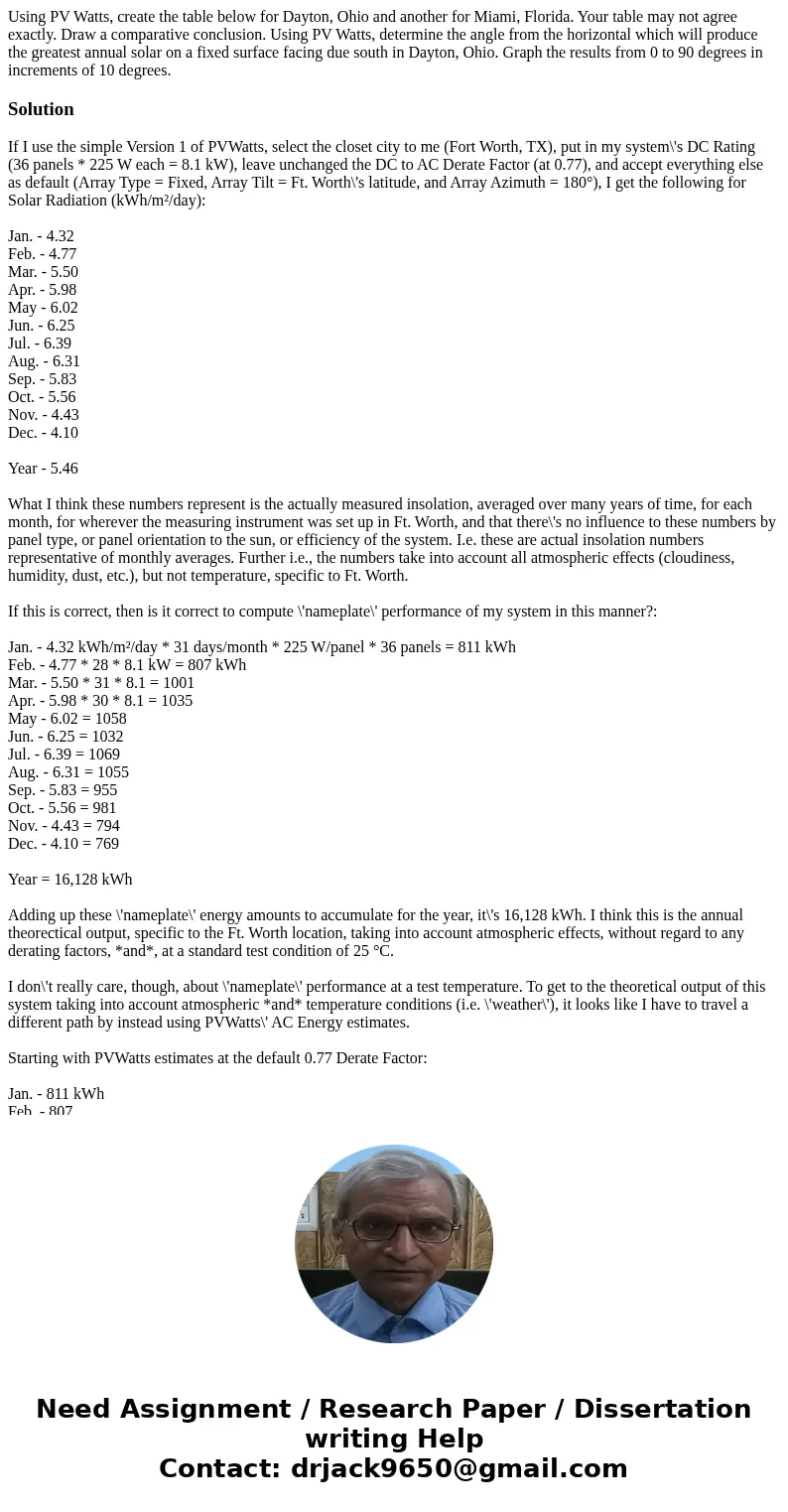Using PV Watts create the table below for Dayton Ohio and an
Solution
If I use the simple Version 1 of PVWatts, select the closet city to me (Fort Worth, TX), put in my system\'s DC Rating (36 panels * 225 W each = 8.1 kW), leave unchanged the DC to AC Derate Factor (at 0.77), and accept everything else as default (Array Type = Fixed, Array Tilt = Ft. Worth\'s latitude, and Array Azimuth = 180°), I get the following for Solar Radiation (kWh/m²/day):
Jan. - 4.32
Feb. - 4.77
Mar. - 5.50
Apr. - 5.98
May - 6.02
Jun. - 6.25
Jul. - 6.39
Aug. - 6.31
Sep. - 5.83
Oct. - 5.56
Nov. - 4.43
Dec. - 4.10
Year - 5.46
What I think these numbers represent is the actually measured insolation, averaged over many years of time, for each month, for wherever the measuring instrument was set up in Ft. Worth, and that there\'s no influence to these numbers by panel type, or panel orientation to the sun, or efficiency of the system. I.e. these are actual insolation numbers representative of monthly averages. Further i.e., the numbers take into account all atmospheric effects (cloudiness, humidity, dust, etc.), but not temperature, specific to Ft. Worth.
If this is correct, then is it correct to compute \'nameplate\' performance of my system in this manner?:
Jan. - 4.32 kWh/m²/day * 31 days/month * 225 W/panel * 36 panels = 811 kWh
Feb. - 4.77 * 28 * 8.1 kW = 807 kWh
Mar. - 5.50 * 31 * 8.1 = 1001
Apr. - 5.98 * 30 * 8.1 = 1035
May - 6.02 = 1058
Jun. - 6.25 = 1032
Jul. - 6.39 = 1069
Aug. - 6.31 = 1055
Sep. - 5.83 = 955
Oct. - 5.56 = 981
Nov. - 4.43 = 794
Dec. - 4.10 = 769
Year = 16,128 kWh
Adding up these \'nameplate\' energy amounts to accumulate for the year, it\'s 16,128 kWh. I think this is the annual theorectical output, specific to the Ft. Worth location, taking into account atmospheric effects, without regard to any derating factors, *and*, at a standard test condition of 25 °C.
I don\'t really care, though, about \'nameplate\' performance at a test temperature. To get to the theoretical output of this system taking into account atmospheric *and* temperature conditions (i.e. \'weather\'), it looks like I have to travel a different path by instead using PVWatts\' AC Energy estimates.
Starting with PVWatts estimates at the default 0.77 Derate Factor:
Jan. - 811 kWh
Feb. - 807
Mar. - 1001
Apr. - 1035
May - 1058
Jun. - 1032
Jul. - 1069
Aug. - 1055
Sep. - 955
Oct. - 981
Nov. - 794
Dec. - 769
Year - 11,367
Then, to get to theoretical system output, taking into account all weather (atmospheric *and* temperature) conditions, but before any considerations for wiring, string design, shading, etc., these numbers need to be divided by the default 0.77 Derate Factor, i.e.:
Jan. - 811 / 0.77 = 1055 kWh
Feb. - 807 etc.
Mar. - 1001
Apr. - 1035
May - 1058
Jun. - 1032
Jul. - 1069
Aug. - 1055
Sep. - 955
Oct. - 981
Nov. - 794
Dec. - 769
Year - 11,367 / 0.77 = 14,762 kWh


 Homework Sourse
Homework Sourse